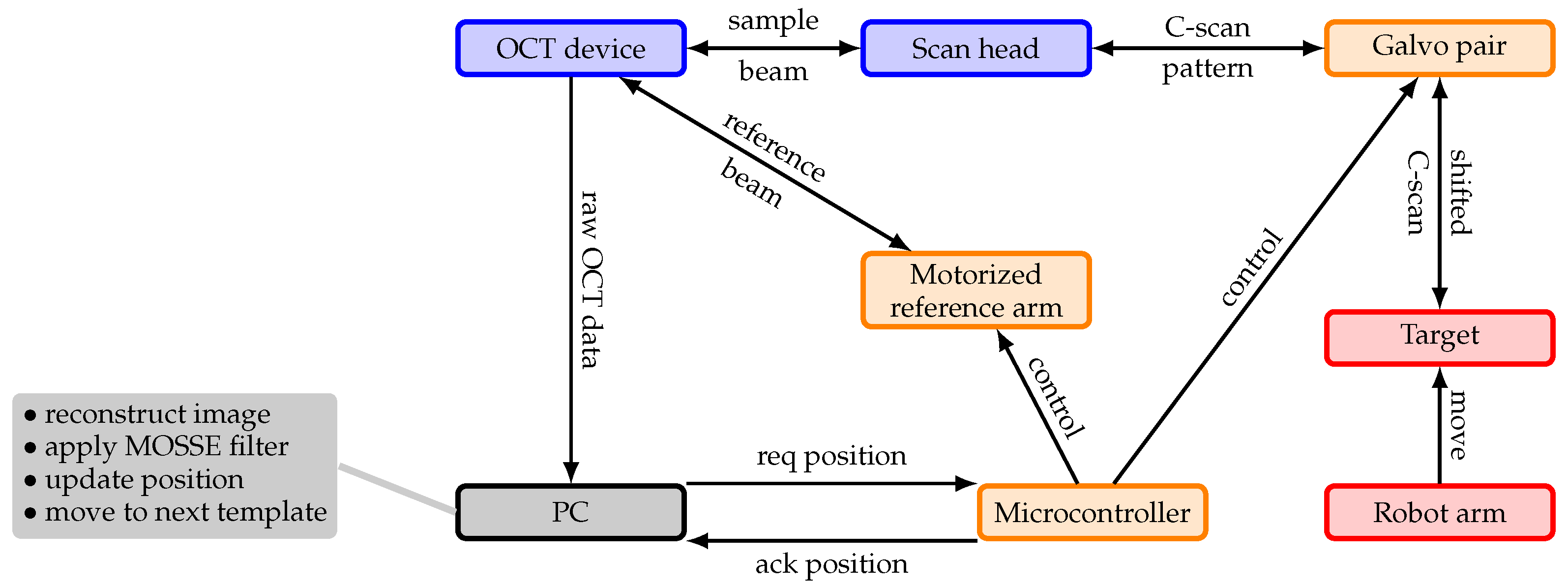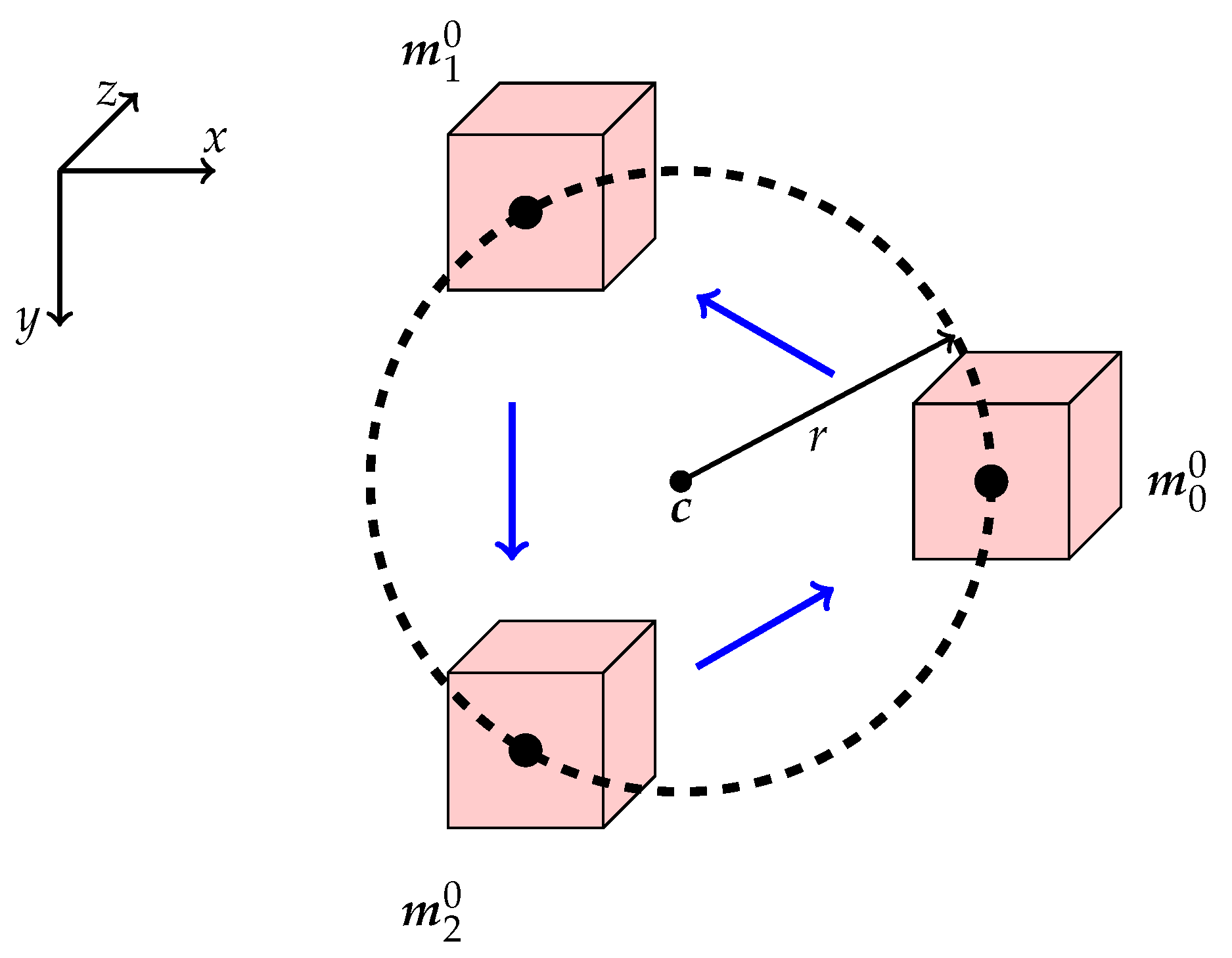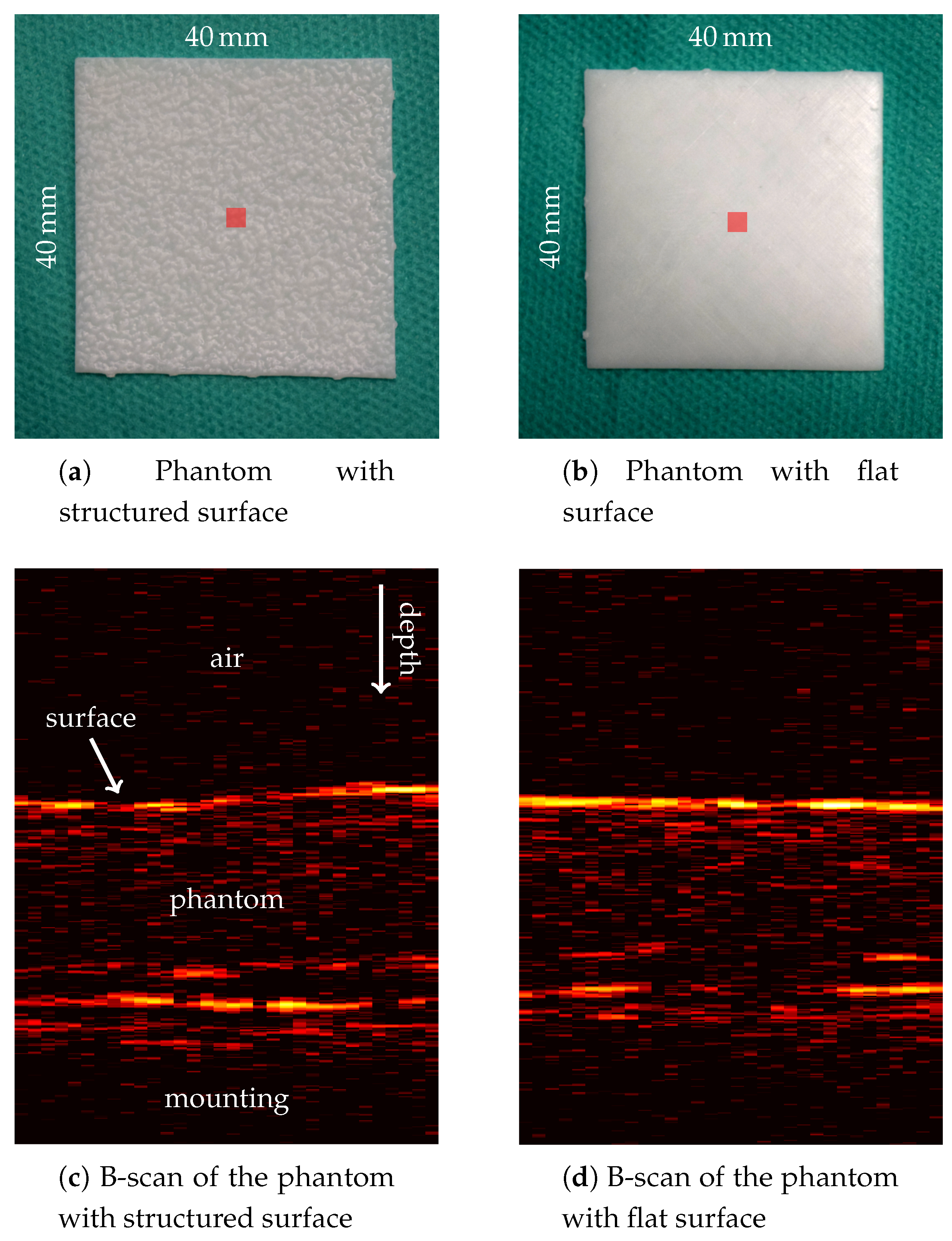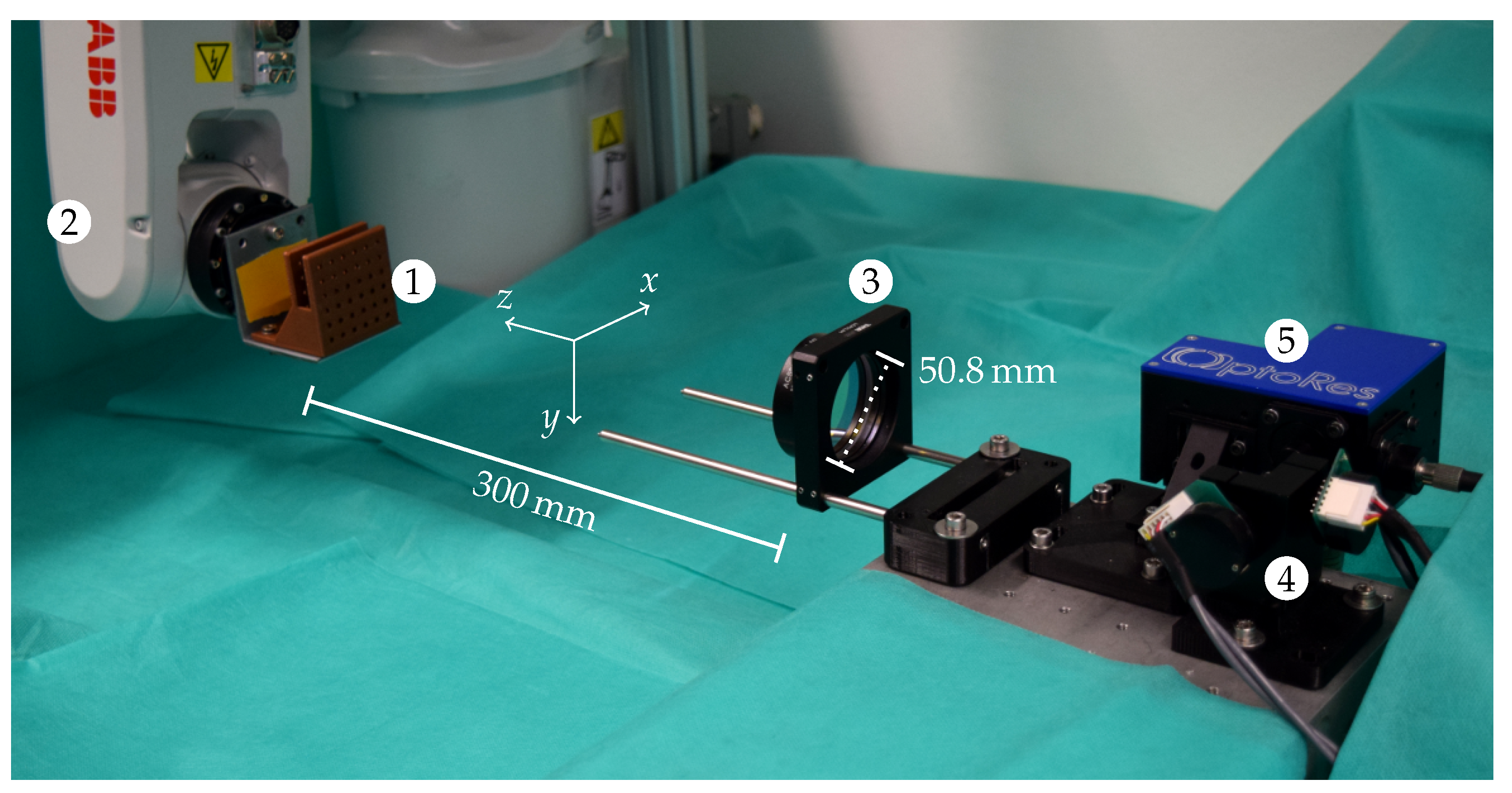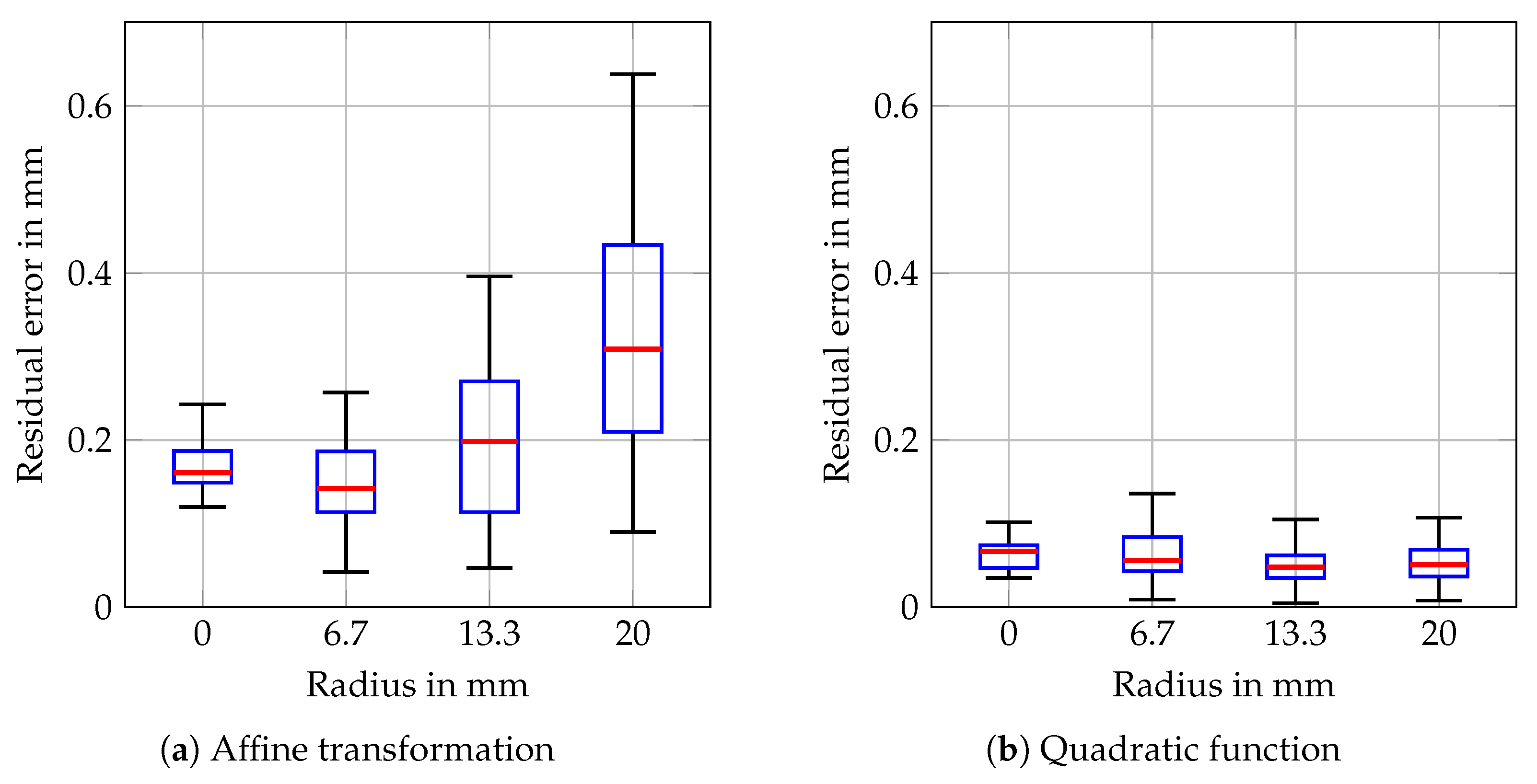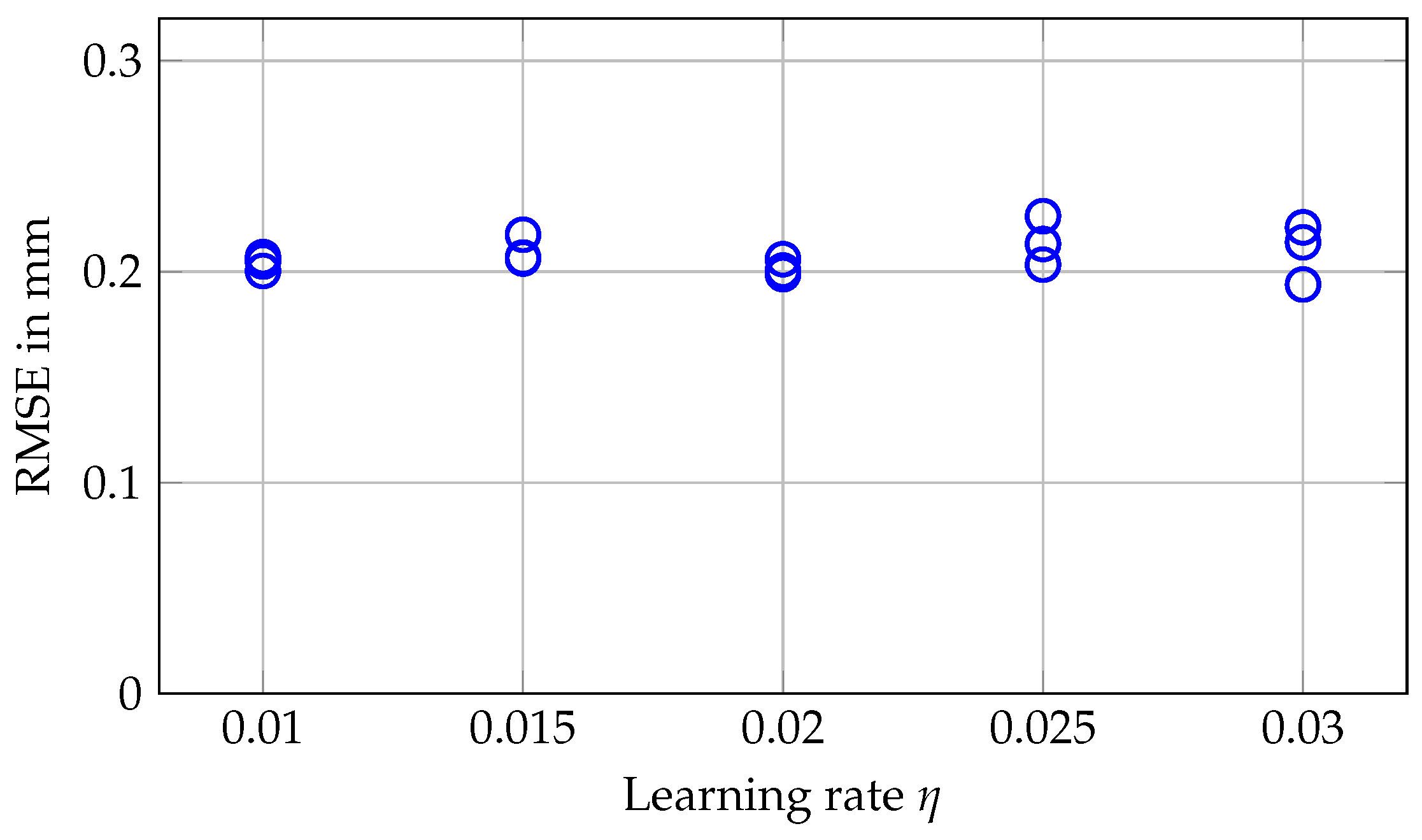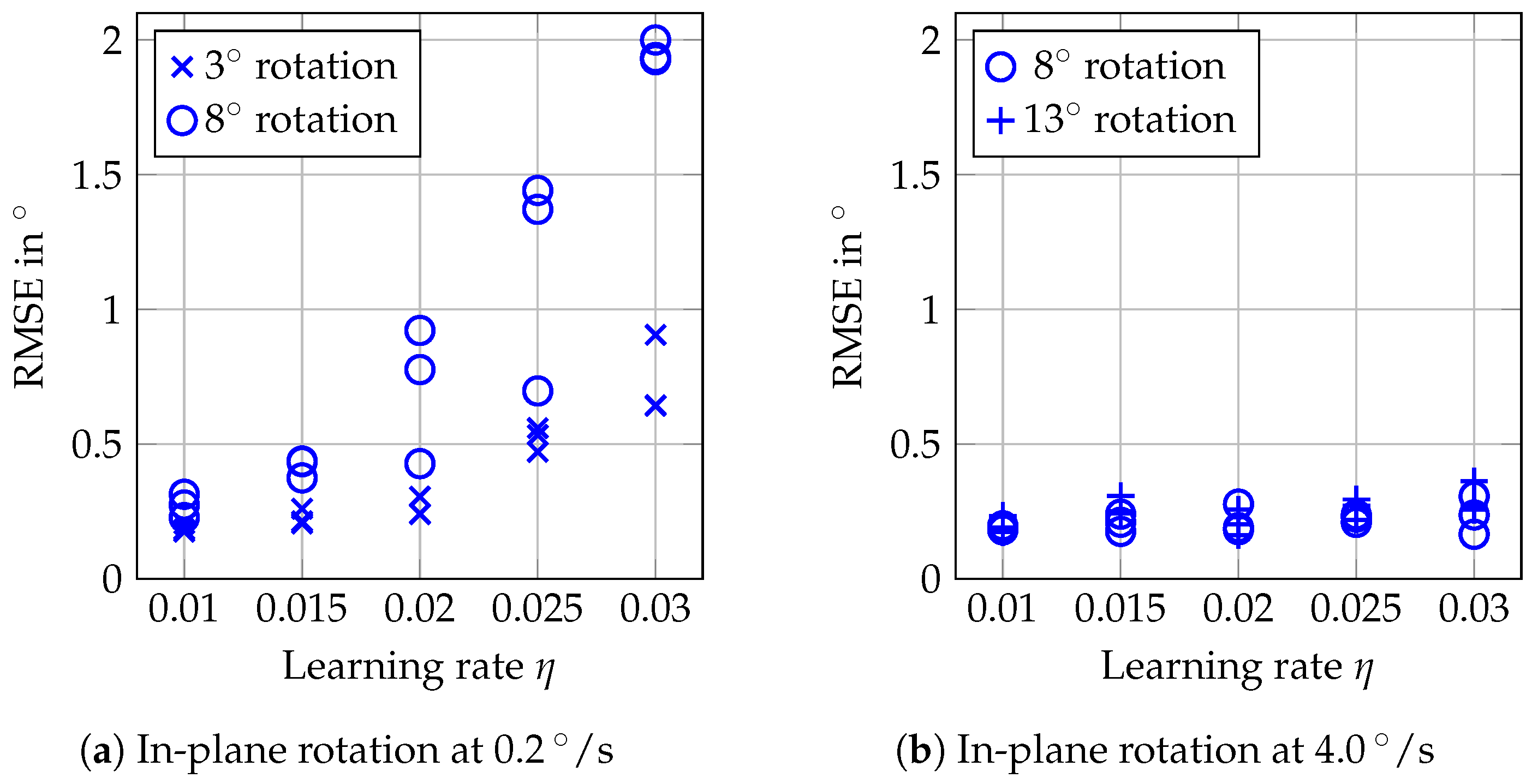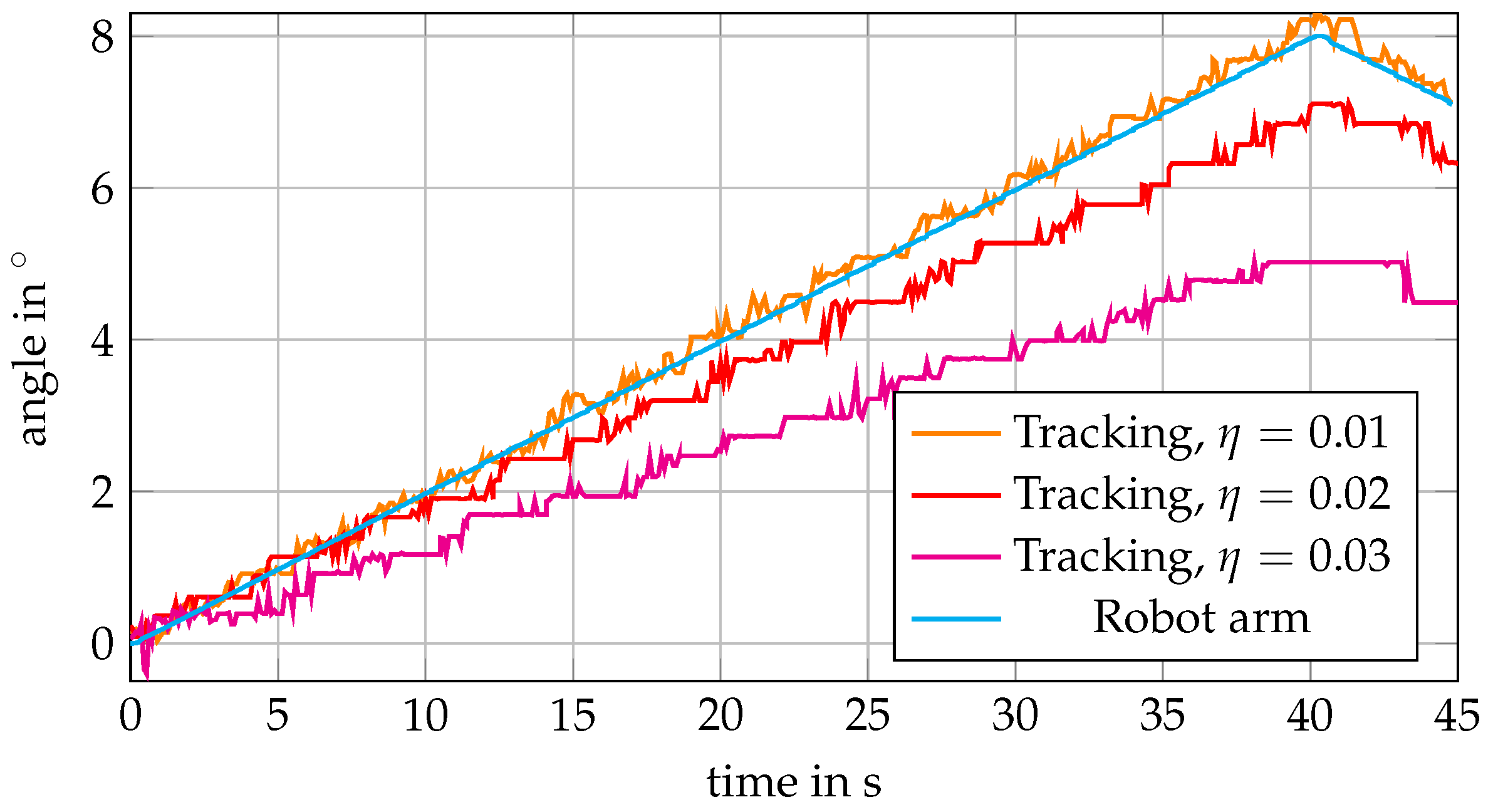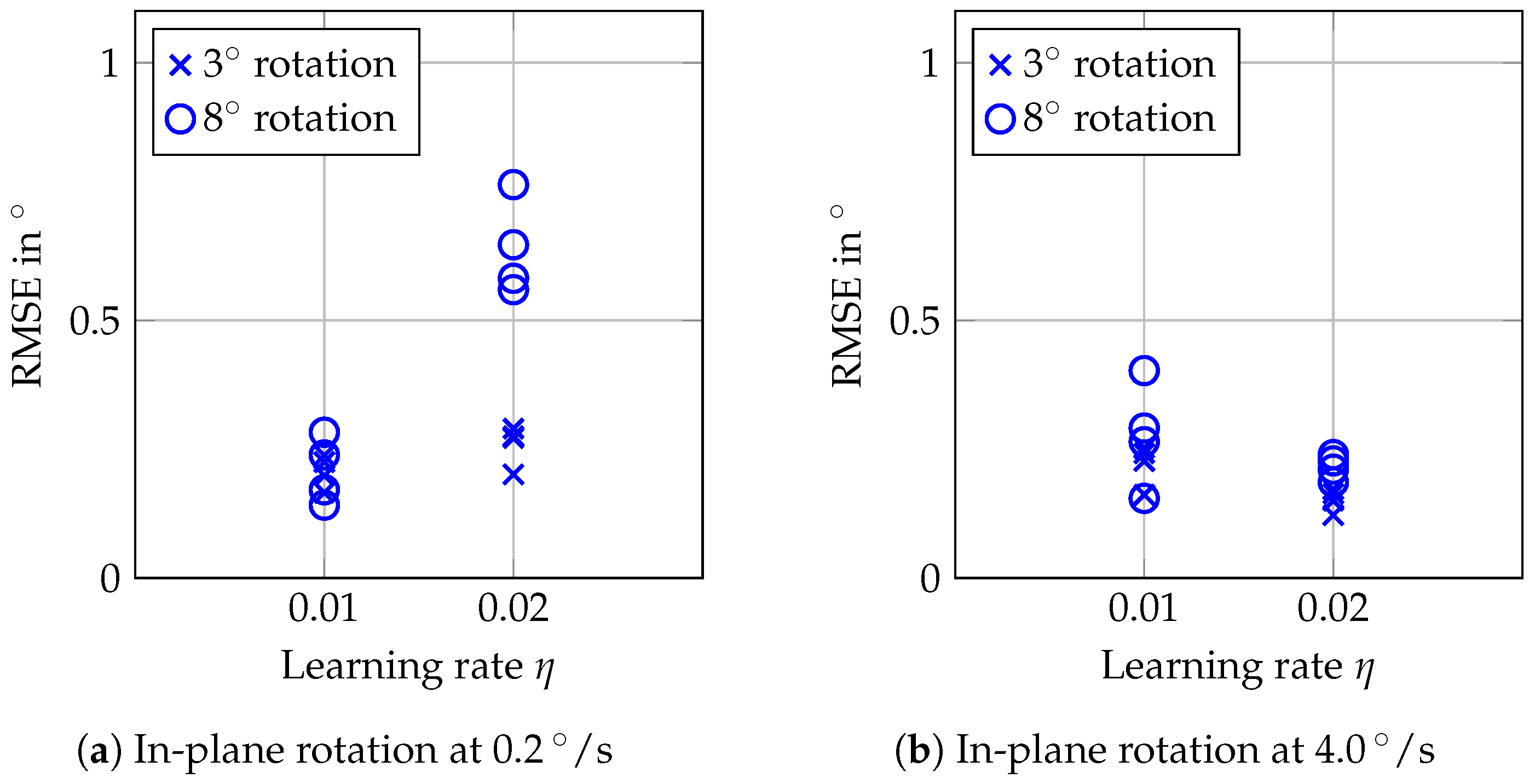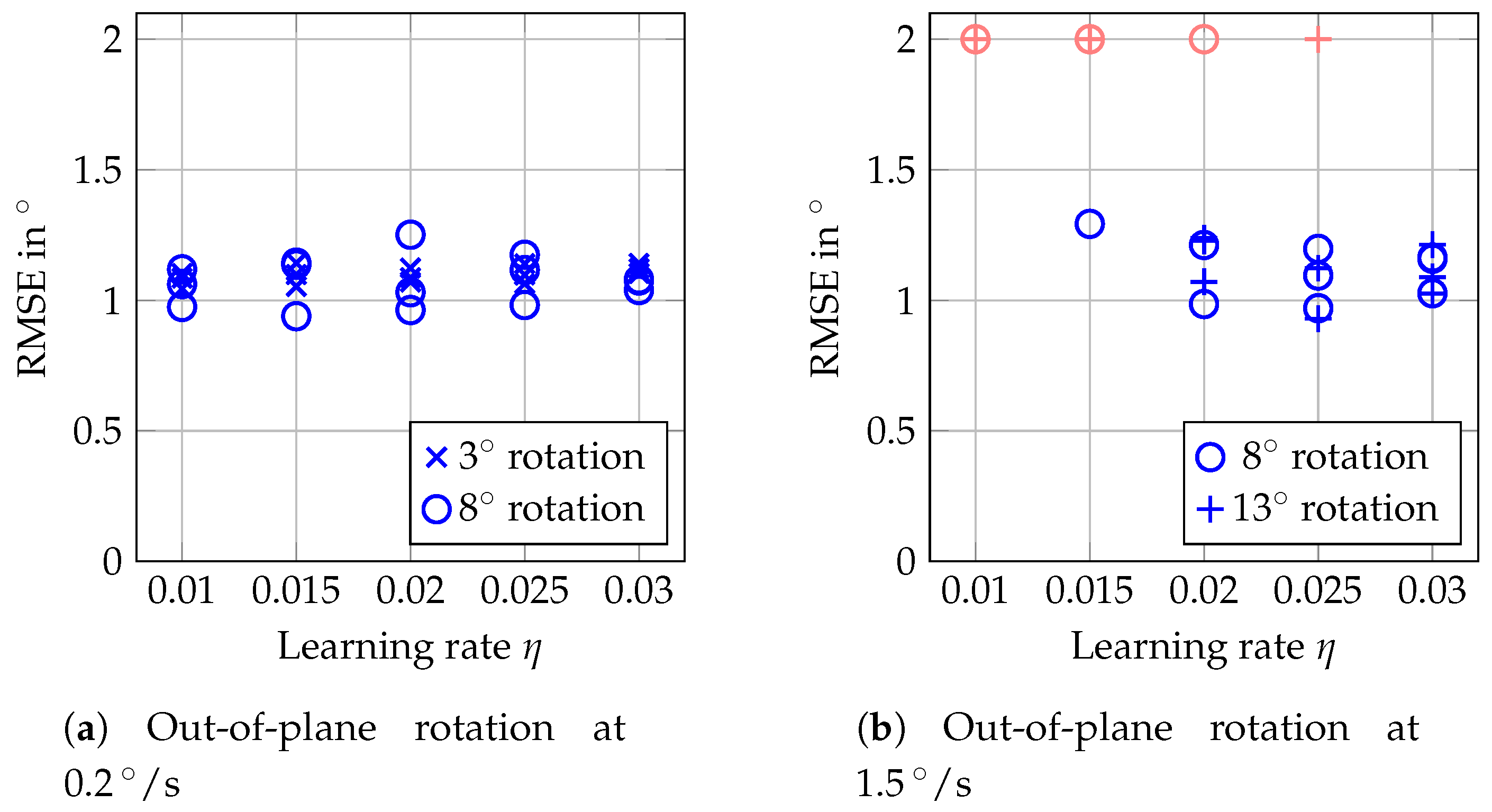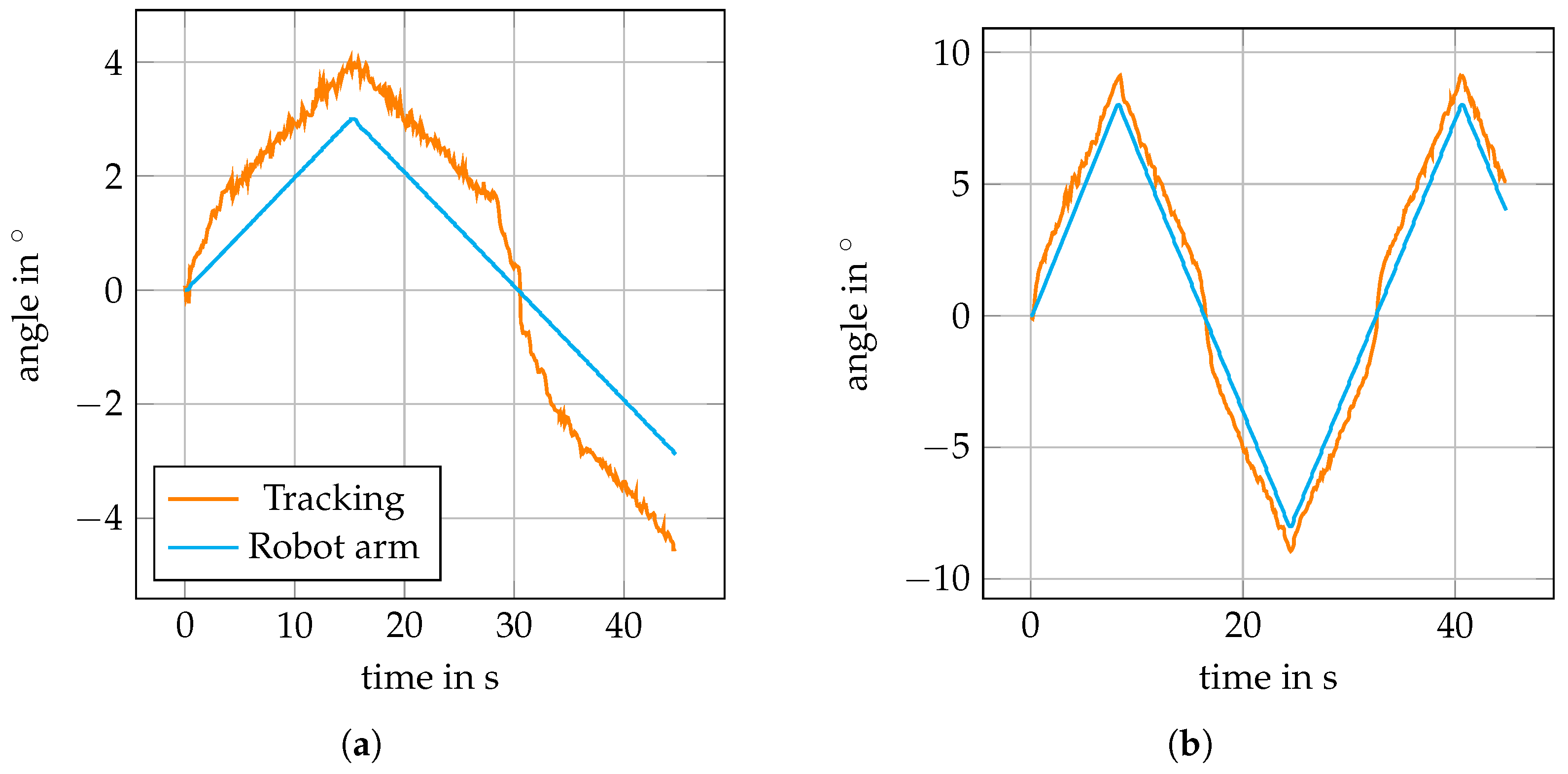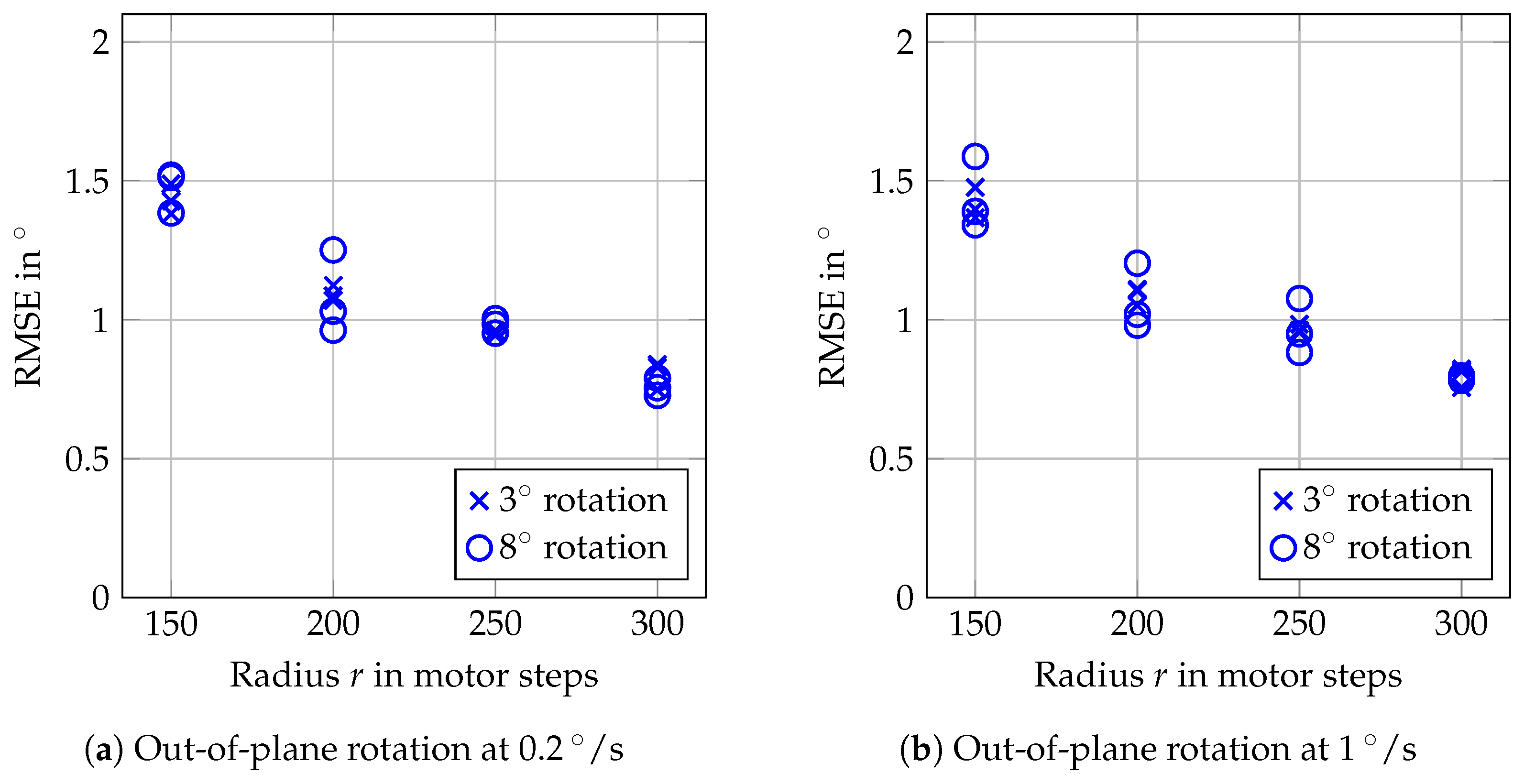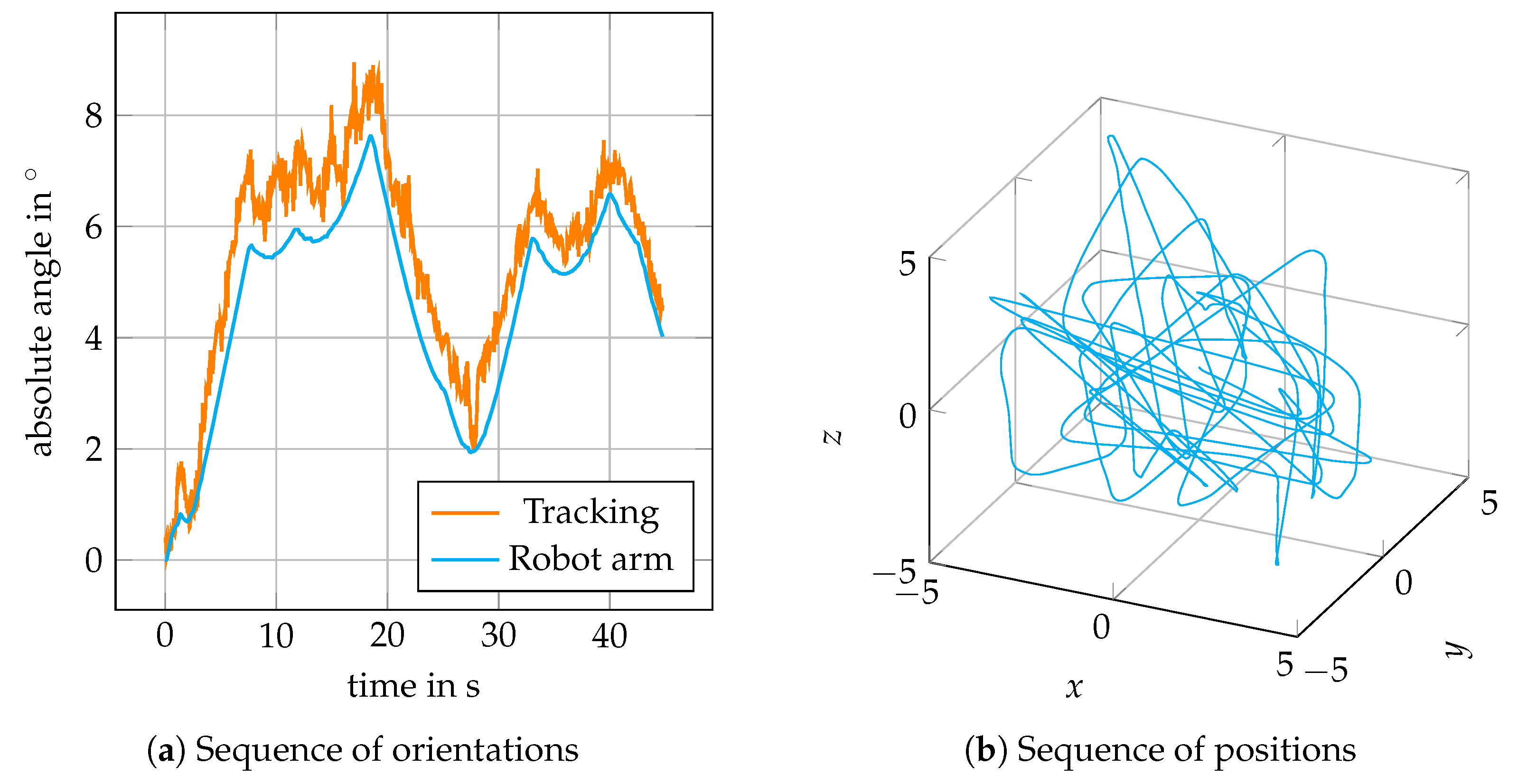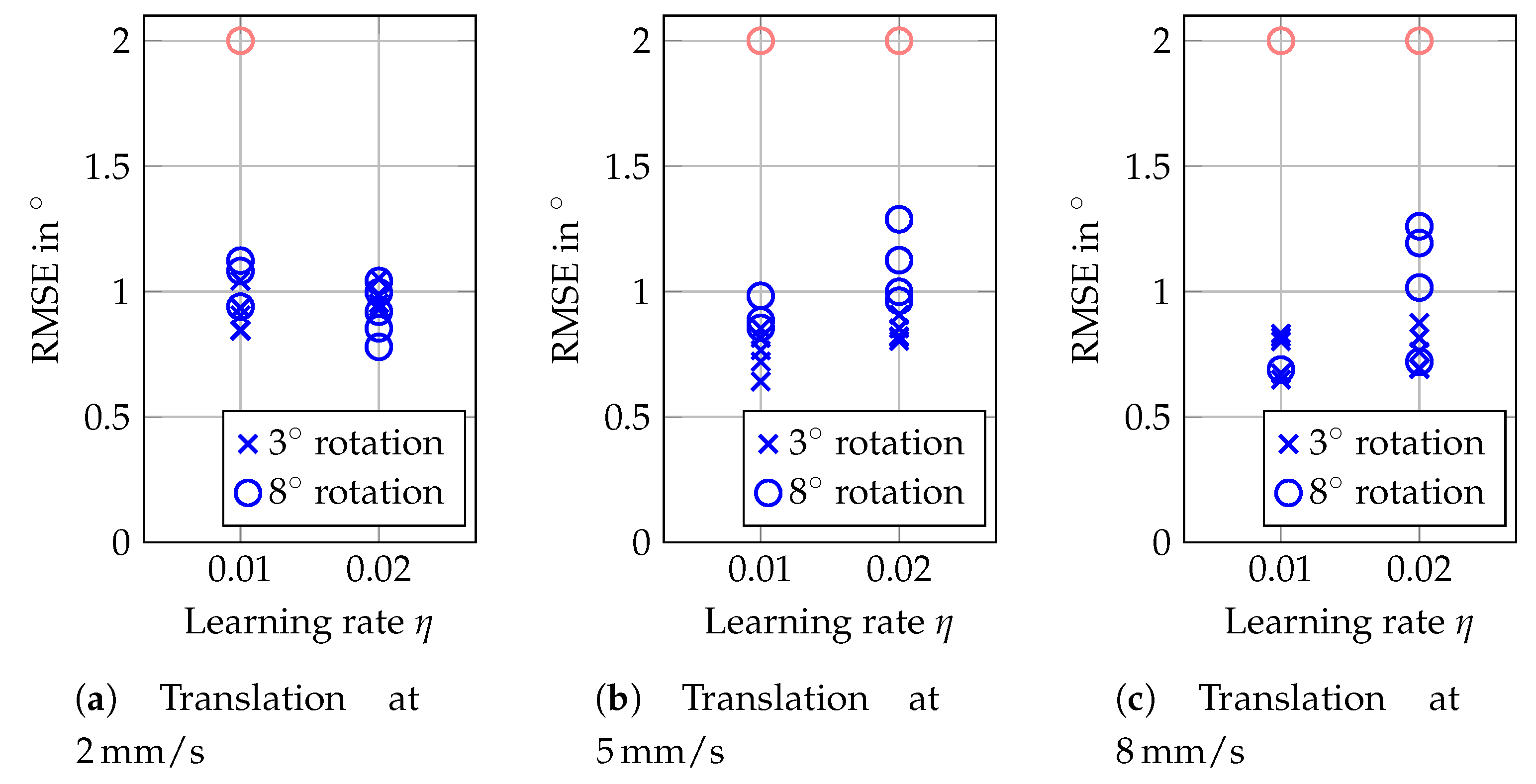1. Introduction
Optical tracking is an established approach in a wide range of applications to estimate or compensate the motion of a target. One particularly important field is the navigation of medical procedures, for example, in radiation therapy, neurosurgery, laparoscopy, or orthopedic surgery. In some fields, we mainly consider the tracking of rigid structures, which can be described by their pose; i.e., position and orientation in space. A classic example is the human skull during surgeries [
1]. Optical markers can be used to determine the pose with respect to some reference frame. However, marker placement is critical for the accuracy of the approach [
2]. Accurate head tracking is also fundamental in cranial radiosurgery. If the patient moves his head during the treatment, we irradiate healthy areas instead of the tumor. Therefore, we have to detect any larger motion to stop treatment and avoid damage. To reduce the likelihood of such situations, different approaches to immobilize the head can be employed; for example, stereotactic frames or thermoplastic masks. These approaches, however, reduce patient comfort and can make patient positioning more difficult. Additionally, there is always some residual motion in the case of masks. For these reasons, head tracking is an important approach, especially because systems like the CyberKnife (Accuray) allow one to dynamically adjust the direction of the treatment beams. However, this requires continuous tracking of the head’s pose with high accuracy and low latency. Markerless approaches to this task employ, for example, structured light [
3] or time-of-flight cameras [
4]. Extending point cloud models with additional information, such as tissue thickness estimation, has been proposed [
5]. Another application for head tracking in medicine is robotic transcranial magnetic stimulation (rTMS). In rTMS, we use a robot to place a coil closely to the patient’s head. This coil non-invasively stimulates a brain region with magnetic pulses. Tracking the head’s pose is fundamental to continuously adapting the coil pose and ensuring steady stimulation of the correct brain region.
Another class of targets constitutes moving and deforming structures within the patient. In abdominal radiosurgery, liver or prostate motion has to be tracked for correct irradiation. If respiration is the cause of the motion, external optical markers can serve as a surrogate to estimate the internal motion [
6]. Direct optical tracking of organs frequently occurs in minimally invasive surgeries, such as laparoscopy. While markerless instrument tracking [
7] can typically exploit clear and known geometries, this is not the case for organs. Their borders might not be within the imaging range, their shapes and appearances can substantially vary between patients, and textural features on their surfaces can be rare and sensitive to moisture, illumination, and other external conditions. Recently, there has been an increasing interest in integrating augmented reality (AR) and mixed reality (MR) in the operating rooms, especially due to the release of devices such as HoloLens (Microsoft) [
8]. While virtual reality (VR) is mainly increasing the efficiency of training or planning applications, AR and MR promise to provide information more concise and intuitive to the surgeon during actual interventions [
9,
10,
11]. Instead of observing visualizations and data on several monitors, information is directly fused and visualized by superimposing it to the surgeon’s current view onto the patient. Therefore, they require one to solve several processing tasks, such as object detection, segmentation, 3D scene reconstructions, registration with previous data, localization, and pose estimation. Furthermore, all these tasks have to be solved online with small delays in order to provide an acceptable perception. This emphasizes that efficient solutions for high-accuracy tracking in difficult environments are still an important topic today.
In summary, highly accurate tracking is an important issue for various applications involving navigation, robotics, and VR/AR. If we want to overcome the limitations of markers, most approaches are limited to targets with clear or known textures or borders. This is problematic in cases of unknown smooth surfaces and under difficult conditions, like limited space. For these reasons, we propose to consider the imaging modality optical coherence tomography (OCT) for markerless tracking. The basis of OCT are one-dimensional interferometric measurements employing near-infrared light, typically at a center wavelength which experiences rather little absorption in water. Thereby, it is possible to acquire depth profiles (A-scans) containing information about reflecting structures below the surface, which are not accessible with superficially scanning modalities. In general, the imaging range of an A-scan covers only few millimeters, but it provides micrometer-scale resolution and acquisition rates above 1 MHz [
12]. Scan heads, typically utilizing galvanometer mirrors (galvos), allow one to laterally translate the OCT beam to obtain sequences of A-scans representing cross-sectional (B-scans) or volumetric images (C-scans). With the latest systems, even high-resolution C-scans can be acquired at video rate [
13] and with low motion artifacts [
14].
OCT imaging is an established technique in ophtalmology, but it is also increasingly being used in other fields, for instance, in intravascular diagnosis in cardiology [
15] or dermatology [
16]. OCT has also been studied to guide interventions like cochleostomy [
17] or to monitor medical lasers [
18,
19]. For intra-operative applications, integration of OCT scanning into surgical tools has been proposed [
20,
21]. OCT has been studied for image registration in the contexts of tracking of artificial markers [
22] and video stabilization [
23]. Additionally, different deep-learning approaches have been evaluated recently for learning known marker geometries [
24] or evaluating optical flow [
25]. However, the constantly limiting aspect when using OCT imaging is the very small field-of-view (FOV). Although experimental systems allowing for larger-scale OCT imaging by different techniques have been described [
26,
27,
28], the FOV of commercial systems is still limited to some millimeters in every direction. In clinical applications, this often leads to using a second modality to guide the actual OCT imaging; for example, angiography in cardiology for catheter placement. To overcome the limited size of the FOV, different approaches have been studied. They usually involve moving the OCT scan head—for example, by integration into a motorized microscope [
29] or by mounting it to a robot [
30], and some kind of volume stitching [
31]. As an alternative which does not require moving the scanning system, we recently proposed a setup which uses a second pair of galvos to laterally move the FOV to different locations [
32]. By additionally using a motorized reference arm, the FOV can also be shifted axially. Besides volume stitching, this setup also allows one to compensate for translational motion of a target by dynamically adjusting the FOV position and to recover its trajectory [
33]. However, this approach is so far limited to 3D tracking.
In this work, we describe a concept for employing OCT to setup a generic tracking system considering the following key specifications. First, the system should be able to estimate trajectories of 6D motion, i.e., translations and rotations of a rigid target, in a range that substantially exceeds the very limited FOV size. Second, it realizes fully markerless tracking; i.e., no target-specific information is required. Third, targets can be tracked without having their borders in the FOV or even without having a clearly textured surface at all by exploiting OCT’s sub-surface information.
2. Material and Methods
In this section, we first describe the hardware setup of our system, which consists of an OCT device and a setup to dynamically reposition the OCT’s FOV. Repositioning the FOV allows one to follow a moving target. We first describe a single-template concept and then propose a multi-template concept which allows one to estimate 6D motion by tracking multiple points on a target. For tracking of the different templates, we employ a MOSSE filter. Finally, we describe in this section a calibration procedure to obtain a Cartesian coordinate frame and the experimental setup for our experiments and evaluations. The overall system is sketched in
Figure 1.
2.1. Hardware Setup
For imaging, we employ a commercially available swept-source OCT device (OMES, Optores), which consists of an FDML laser, an imaging module, and a scan head. The device has a center wavelength of 1315 nm and provides an A-scan rate of 1.59 MHz, where each A-scan is reconstructed from 2432 raw data samples. By closing a shutter in the sample arm, we estimate the background signal and subtract it from the raw data. The non-linearity of the laser’s sweep is estimated by branching off a recalibration arm from the reference arm and processing the recalibration signal with a correction algorithm provided by the manufacturer’s SDK. Image reconstruction is fully implemented in CUDA to allow for efficient GPU processing. For acquiring C-scans consisting of 32 × 32 axial A-scans, we achieve a C-scan rate of 831 Hz by using a scan head with one resonant galvanometer mirror. We use a lateral scan area of approximately 2.5 mm × 2.5 mm and crop the A-scans to 480 pixels which cover approximately 3.5 mm axially.
We placed a pair of galvos in front of the scan head, which allows one to shift the whole FOV laterally (
Figure 2a). In front of these galvos, we have a lens with a focal distance of 30 mm defining the working distance between our system and the target to be tracked. Further, its diameter of 50.8 mm limits the lateral positioning range to a disk. To shift the OCT’s FOV along its axial direction, we employ the motorized reference arm shown in
Figure 2b. It consists of a fixed mirror and a retroreflector on a linear guide, which is driven by a stepper motor via a belt. When we move the retroreflector, the FOV is shifted by twice the distance. While this reference arm could be used to realize rather large axial shifts, we only consider shifts in this work with similar lateral and axial ranges.
In summary, our setup allows one to shift the FOV in 3D space by selecting a three-dimensional vector of motor steps, where and refer to lateral shifting by the two galvos and to axial shifting by the motorized reference arm. The motor and galvos are controlled by a microcontroller which communicates with our measurement PC. The PC has a digitizer board (ATS9373, Alazartech) for OCT data acquisition and two GPUs (GTX Titan X and GTX 980 Ti, Nvidia). We use one of the GPUs for image reconstruction, and the second one is available for further data processing; i.e., implementation of a tracking algorithm.
2.2. Single-Template Tracking
In order to track a moving target and to adjust the FOV position accordingly, we generally employ a template-based approach. Given a template C-scan
and a later C-scan
, an image processing algorithm determines the translation
measured in voxels. This translation is converted into a new vector of motor steps
as
where
C is a matrix converting voxels into motor steps and
and
are proportional gains for the movement of the galvos and the stepper motor, respectively. We assumed that
C is a diagonal matrix—i.e., each motor axis is exactly identified with one OCT axis—which turned out to be sufficient for the feedback loop in our setup. We estimated the lateral conversion factors to be 2.5 steps/voxel and the axial conversion to be 0.7 steps/voxel. Note that the axial voxel spacing is substantially smaller than the lateral.
2.3. Multi-Template Tracking
The pose of a rigid body can be determined from the locations of three non-collinear points. Therefore, to estimate the orientation in addition to the positions of our moving targets, we simultaneously track multiple templates which are spatially separated. We consider
N templates and their corresponding initial FOV positions
,
, and arrange them on a circle with radius
r around a suitable center point
, as shown in
Figure 3. Therefore, we have
as the initial motor positions. For targets which are not sufficiently flat within radius
r, we could also define the templates at different depths. However, we assume for now that this is not necessary.
We track these
N templates sequentially. In iteration
i for template
n, we acquire a C-scan
at position
; compute its translation with respect to
and convert it to motor steps
; and determine the next position
according to Equation (1). Afterwards, we do the same steps for the next template. However, we can pipeline these operations as sketched in
Figure 4 to increase the tracking rate. Note that the most time-consuming part in our setup is moving the FOV axially by changing the length of the reference arm, especially if the employed stepper motor has to change its direction of travel.
We do not consider
for tracking directly, but only use it to adjust the FOV position. Considering Equation (
1), we see that the appropriate FOV position for
is rather
i.e., without the proportional gains. As a timestamp for this position, we use the acquisition timestamp of
.
2.4. Tracking Algorithm
In previous work [
33], we showed that the phase correlation method is a suitable and efficient tracking algorithm for the single-template setup with purely translational motion. It employs cross-correlation to estimate the translation between a template C-scan and a new template C-scan. By using a Fourier-domain approach, phase correlation has very low computational cost.
However, if we also observe substantial rotations, which we cannot compensate by shifting the FOV in our system, then we cannot expect this simple template-based approach to succeed. The rotation has a severe impact on the appearance of the target in the C-scan, and matching with the template C-scan will quickly fail due to the decaying similarity. More recently developed adaptive correlation filters extend the Fourier domain approach of the phase correlation method to gradually alter the filter’s target representation and allow target tracking through appearance changes [
34]. We chose to use the MOSSE (minimum output sum of squared error) filter [
35] that offers high computational speed, online filter adaptation, and a straightforward extension from two-dimensional to volumetric image data.
Following Bolme et al. [
35], we summarize the key concepts of the MOSSE filter for three-dimensional images. It typically does not employ a single template image
,
, but constructs an optimal filter
in the Fourier domain from
T training images
. This reduces the noise and makes the filter more robust and stable. Let
be the three-dimensional Fourier transform of
. The complex conjugate of the filter
is then constructed from the training images as
where
is a small regularization constant.
is the Fourier transform of a Gaussian function
which is shifted by
and represents a smoothed version of the desired filter output. The vector
represents the translation which the filter should determine for input
; i.e., the training images do not have to be centered in this algorithm. During tracking, we then obtain the translation
of a new image by transforming the image to the Fourier domain, multiplying it with
, and applying the inverse Fourier transform to the product. The location of the highest intensity in this result corresponds to the translation of the new image with respect to the filter. The advantage of allowing for arbitrarily shifted images for training becomes even more apparent when considering updating the filter during tracking to adapt to appearance changes. The filter can be updated after each evaluation of a new image. When we evaluate the
i-th image
during tracking, we obtain its translation
from the current filter
as described above. Note that we use superscript indices for the image sequence during actual tracking and subscript indices for the training images. The determined translation
defines the target output
of the
i-th image, and the updated filter is recursively updated as
with nominator
denominator
and learning rate
. The higher
, the more influence the new image has on the filter. Updating templates always leads to a critical trade-off [
36]. On the one hand, it allows for compensating stronger changes in appearance, but on the other hand, it also increases the likelihood of a drift; i.e., the filter no longer tracks the original target after some time but a structure at another location.
In our implementation, we use ten training images initially acquired at the same position. We use for the Gaussians and further set . We update the filter each time we evaluate a new image and compare different learning rates . The algorithm is implemented in CUDA for processing on a GPU.
2.5. Cartesian Calibration
Neither the C-scans nor the motor positions form a Cartesian coordinate frame with physical units. Therefore, we need a calibration to obtain proper coordinates, especially to calculate meaningful orientations from the motor positions. For this purpose, we can use a 3D motion stage and single-template tracking with the phase correlation algorithm to acquire calibration data [
33]. We move a marker slowly to different positions within a volume-of-interest with active tracking. Thereby, we obtain
M pairs of positions
of the motion stage and motor positions
of the tracking system. We can firstly determine an affine transformation matrix
by solving
This matrix compensates for the overall offset, aligns the axes, and scales the motor steps to millimeters between the coordinate frame of the motor positions and the Cartesian frame of the motion stage. However, the rotating galvos introduce some spherical distortions which cannot be adequately represented by an affine transformation. Therefore, we secondly fit a three-dimensional quadratic function
to finally obtain Cartesian motor positions
as
2.6. Pose Estimation
We estimate the position of the target in iteration
i as the centroid of the
N Cartesian motor positions
,
. For this purpose, we resample the positions of the
N templates to common timestamps. To estimate the orientation in iteration
i, we apply the Kabsch algorithm [
37] to the positions
and the corresponding initial positions
of the templates.
2.7. Phantoms and Simulated Motion
As targets for tracking, we consider the phantoms shown in
Figure 5. The 40 mm × 40 mm sized plates have a thickness of about 1 mm. They are 3D-printed using photopolymer resin and we receive OCT signals from their backsides as well. The back sides of the plates are rough and randomly structured to simulate sub-surface information. The front side of the first phantom shows the same structure, while the second phantom has a flat surface, instead.
We use a 6-axis robot arm (IRB 120, ABB) to simulate and evaluate different motion patterns. As shown in
Figure 6, the end-effector has a sample holder attached to position a phantom about 300 mm in front of the lens of the tracking system. It is positioned such that the axes of its base coordinate frame are approximately aligned to the OCT’s and the tracking system’s axes. This allows one to systematically evaluate two types of rotations. We define in-plane rotations to be in a plane parallel to the OCT’s
-plane. Therefore, the axis of rotation corresponds to the axial scan direction of the OCT, and hence motion can mostly be compensated by only moving the second pair of galvos while the reference arm length does not have to be adjusted. The other type is out-of-plane rotations, which we define to be in the OCT’s
-plane.
To evaluate pure translations, we move the robot arm’s end-effector back and forth along a line. For rotations, we rotate in-plane or out-of-plane starting with the original end-effector orientation. Furthermore, we consider random 6D motion. For the sequence of positions, we uniformly draw random points within a cube. For the sequence of rotations, we define a random axis of rotation and uniformly draw a random angle. The positions and the orientations are then realized simultaneously by the robot arm. Each experiment consists of a motion sequence which we record over 45 s. For each repetition, we acquire the templates at a different randomly selected spot on the phantoms before motion starts.
We also use the robot arm to perform the Cartesian calibration. In detail, we move the structured-surface phantom to 80 different positions within a cylinder with a radius of 20 mm and a depth of 40 mm. We only move at 2 mm/s to ensure reliable tracking. At each position, we log the tracking system’s position ten times.
2.8. Evaluation Metrics
For pure translations, we evaluate the Euclidean norm of the differences between the relative positions of the robot and those of our tracking system. To evaluate orientations, we use the axis-angle representation, which provides an angle
which is independent of coordinate systems. Evaluating the six degrees of freedom individually would require one to express translations and rotations in a common frame. While hand-eye calibration could be used to relate the robot and OCT-based tracking system [
30,
38], it would also be limited by the same system components we use in our setup for tracking, and the residual calibration error would affect the evaluation of the tracking approach. Therefore, we consider the relative rotations in the robot frame and the tracking-system frame independently and compare their magnitudes, which include all three rotational degrees of freedom. Similarly, we established the magnitude of the translation as the Euclidian distance. We mainly consider the root-mean-squared error (RMSE) to describe the results, either with respect to the translations or to the angles.
4. Discussion
Conventional optical tracking systems or cameras usually rely on either textured surfaces, or surfaces with varying height, visibility of borders, or artificial markers. In contrast, out proposed tracking approach allows one to track translations and rotations markerlessly, even for the phantom with a smooth surface and no visible borders. We are able to track translations with RMSEs below 0.25 mm (
Figure 8). Tracking of in-plane rotations is feasible with errors below 0.3° (
Figure 9), even for a large target with a flat surface (
Figure 11). By employing OCT, we can exploit micrometer-scale volumetric image data including information about the structure below the surface. Furthermore, imaging is non-invasive and feasible at high temporal resolution.
For our tracking approach using an adaptive MOSSE filter, the choice of the learning rate
can be critical. While increasing
leads to severe underestimation of angles for in-plane rotations (
Figure 10), a higher
is necessary for reliable tracking of out-of-plane rotations (
Figure 12). This is a general issue, and for an application one should consider which type of motion can be expected. Depending on the velocities expected, either a smaller or a higher learning rate should be chosen. Furthermore, one could consider an approach where the learning rate is adapted online based on the last observed velocities [
39].
Tracking of out-of-plane rotations generally performs worse than tracking of in-plane rotations, which only involves the pair of galvos for adjusting the FOV position. The target, however, is still tracked correctly during out-of-plane rotations from a qualitative point of view (
Figure 13), even for more complex motion (
Figure 15). However, the quantitative evaluation (
Figure 12) is distorted by an overestimation of the angles, which occurs throughout all measurements. By arranging the template on a larger circle and by tracking more templates, this effect can be reduced (
Table 1). For specific applications, this can, however, lead to deciding for a trade-off between the accuracy and the size of the area in which motion can be tracked.
